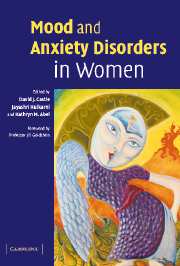Book contents
- Frontmatter
- Contents
- Contributors
- Preface
- Foreword
- 1 Pubertal development and the emergence of the gender gap in mood disorders: A developmental and evolutionary synthesis
- 2 Borderline personality disorder: Sex differences
- 3 Substance use and abuse in women
- 4 Anxiety disorders in women
- 5 Posttraumatic stress disorder in women
- 6 Domestic violence and its impact on mood disorder in women: Implications for mental health workers
- 7 Depression in women: Hormonal influences
- 8 Anxiety and mood disorders in pregnancy and the postpartum period
- 9 Pharmacological treatment of anxiety and depression in pregnancy and lactation
- 10 Bipolar affective disorder: Special issues for women
- 11 Mood and menopause
- 12 Anxiety and depression in women in old age
- Index
Preface
Published online by Cambridge University Press: 13 August 2009
- Frontmatter
- Contents
- Contributors
- Preface
- Foreword
- 1 Pubertal development and the emergence of the gender gap in mood disorders: A developmental and evolutionary synthesis
- 2 Borderline personality disorder: Sex differences
- 3 Substance use and abuse in women
- 4 Anxiety disorders in women
- 5 Posttraumatic stress disorder in women
- 6 Domestic violence and its impact on mood disorder in women: Implications for mental health workers
- 7 Depression in women: Hormonal influences
- 8 Anxiety and mood disorders in pregnancy and the postpartum period
- 9 Pharmacological treatment of anxiety and depression in pregnancy and lactation
- 10 Bipolar affective disorder: Special issues for women
- 11 Mood and menopause
- 12 Anxiety and depression in women in old age
- Index
Summary
The particular mental health experiences of women have received great attention in recent years. This reflects growing concern about the burden of mental health problems on the lives of women and their families. The most common mental health disorders are anxiety and depression, and women are particularly prone to such disorders. “Mood and Anxiety Disorders in Women” uses a biopsychosocial framework to provide a broad contemporary perspective on mood and anxiety in the context of women's lives. A developmental approach affords an overarching structure for the book, with each chapter examining a particular phase of women's lives. Extensive cross-referencing allows a shared perspective across other developmental stages where appropriate.
Chapter 1 provides an overview of the emotional hurdles facing adolescent girls, with particular reference to how these can contribute to the manifestation of psychological and psychiatric problems at this stage of development. Earlier developmental factors are also discussed.
Picking up on some of these themes, Chapter 2 is concerned with personality disorders and women, with a particular emphasis on why women tend to be more vulnerable to certain personality disorders (notably borderline), and less vulnerable than men to others (notably antisocial personality disorder). Aetiopathogenic parameters, including the role of childhood sexual abuse, as well as diagnostic issues, are addressed.
Chapter 3 turns to substance use disorders in women, covering epidemiological, clinical and therapeutic aspects.
- Type
- Chapter
- Information
- Mood and Anxiety Disorders in Women , pp. xi - xivPublisher: Cambridge University PressPrint publication year: 2006

